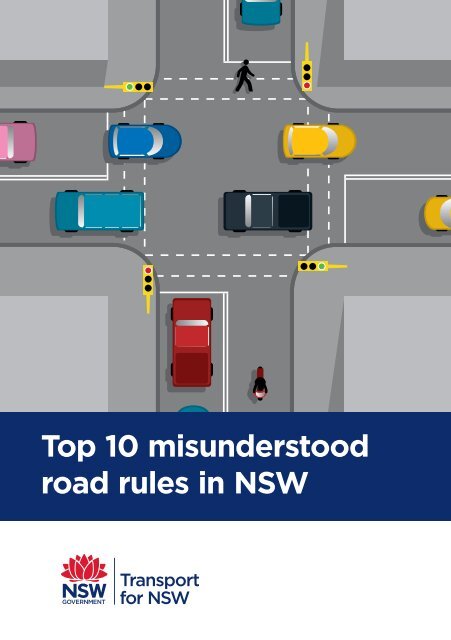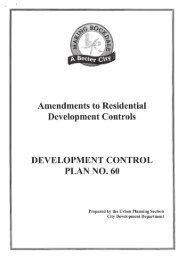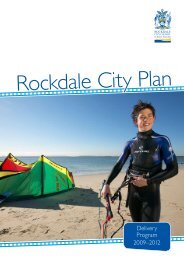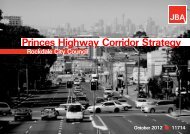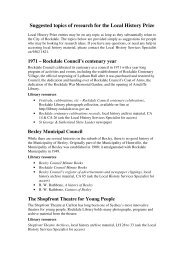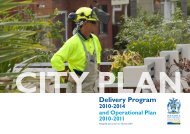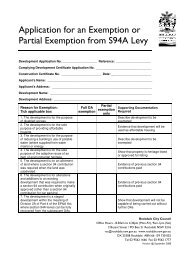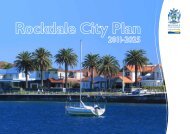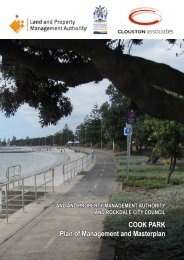Top 10 misunderstood road rules NSW - NRMA
Top 10 misunderstood road rules NSW - NRMA
Top 10 misunderstood road rules NSW - NRMA
- No tags were found...
You also want an ePaper? Increase the reach of your titles
YUMPU automatically turns print PDFs into web optimized ePapers that Google loves.
<strong>Top</strong> <strong>10</strong> <strong>misunderstood</strong><strong>road</strong> <strong>rules</strong> in <strong>NSW</strong>
A simple guide to the most<strong>misunderstood</strong> <strong>road</strong> <strong>rules</strong> in <strong>NSW</strong>If you have further questions about <strong>road</strong><strong>rules</strong>, call 132 213 or visit rms.nsw.gov.auThis document does not constitute legal advice and is provided only as a guideto the Road Rules 2008. Road users must ensure they are familiar with the RoadRules and comply with the requirements prescribed in law.
Contents1 Roundabouts 4Approaching a roundabout 4Entering a roundabout 4Turning left 4Going straight ahead 4Turning right 5Making a U-turn 5Changing lanes in a roundabout 5Exiting a roundabout 52 Giving way to pedestrians when turning 63 Mobile phones 74 Merging 8Merging when the number of lanes is reduced 8Changing lanes when a marked lane ends 85 Keeping left 96 Using headlights and fog lights <strong>10</strong>High beam <strong>10</strong>Must not dazzle <strong>10</strong>Fog lights 11Spot lights 11Lights117 U-turns 128 Safe following distances 139 School zones 14<strong>10</strong> Yellow traffic lights 15
1 RoundaboutsApproaching a roundaboutDrivers approaching a roundabout must use their indicator if theyintend to turn left or right, or make a U-turn at the roundabout. Theymust give other <strong>road</strong> users sufficient notice of their intent to turn.Entering a roundaboutDrivers must slow or stop to give way to any vehicle already inthe roundabout. Drivers must also continue to use their indicator if theyintend to turn left, right or make a U-turn.Turning leftDrivers must indicate left on approach and be travelling in the left-handlane (unless there are <strong>road</strong> markings with other instructions), stay in theleft lane and exit in the left lane.Going straight aheadThere is no requirement for drivers to signal when approachingthe roundabout, if they are going straight ahead.Drivers may approach the roundabout from either the left or right lane(unless there are <strong>road</strong> markings with other instructions).4
Turning rightDrivers must indicate right on approach and be travelling in the righthandlane (unless there are <strong>road</strong> markings with other instructions).Making a U-turnWhen using a roundabout to make a U-turn, drivers must approach inthe right lane and signal right.Changing lanes in a roundaboutDrivers may change lanes in a roundabout if they wish. The usual <strong>road</strong><strong>rules</strong> for changing lanes apply. Drivers must use their indicator and giveway to any vehicle in the lane they are entering.Exiting a roundaboutJust like exiting any <strong>road</strong>, drivers must signal left when leaving aroundabout, if it is practical to do so, and stop indicating as soon asthey have exited the roundabout.When travelling straight ahead on a small single lane roundabout, it maybe impractical to indicate left when exiting.All drivers are required to drive carefully and slow down or stopwhen there is a chance of a crash with another vehicle.5
2 Giving way to pedestrians when turningIf a driver is turning left or right at an intersection, the driver must giveway to any pedestrian crossing the <strong>road</strong> the driver is entering.This applies to intersections with and without traffic lights.For their own safety, pedestrians should always check theirsurroundings before crossing the <strong>road</strong>.6
3 Mobile phonesA mobile phone may only be usedwhile driving:• if it is secured in acommercially manufacturedand designed mounting whichis fixed to the vehicle and doesnot obscure the driver’s viewof the <strong>road</strong>, or• if it can be operated by thedriver without touching anypart of the phone, for examplethrough the use of Bluetoothtechnology or voice activation.While driving, a mobilephone cannot:• rest on the driver’s leg,between the shoulder and ear,or on any other part of thedriver’s body,• be used for text messaging, video messaging, emailing or similar, or• be held in the driver’s hand other than to pass it to a passenger.Drivers can only use a hand-held mobile phone if their vehicle is parkedin an authorised parking spot. They cannot use a hand-held mobilephone while stopped at traffic lights.Drivers may use the navigational or GPS function and audiofunctions of a phone while driving, provided the phone is secured in afixed mounting.Learner and P1 drivers are not permitted to use any functionof a phone while operating a vehicle.7
4 MergingMerging when the number of lanes is reducedWhen a driver is travelling on a <strong>road</strong> without lane markings and thenumber of lanes or lines of traffic is reduced, they must merge bygiving way to any vehicle that is ahead of them. This is often called azipper merge.Car B gives way to Car A.Changing lanes when a marked lane endsWhen a driver is travelling in a marked lane which is ending and isrequired to cross a broken painted line to enter the adjacent lane, thedriver must give way to the traffic travelling in the lane being entered.Car A gives way to Car B.8
5 Keeping leftOn multi-lane <strong>road</strong>s with a speed limit of more than 80km/h, motoristsmust not drive in the right-hand lane unless they are:• overtaking• turning right or making a U-turn• avoiding an obstacle• driving in congested traffic• driving in a special purpose lane or if there is a Left Lane Must TurnLeft sign or a left traffic arrow and the driver is not turning left.If a Keep Left Unless Overtaking sign is displayed, the requirementapplies regardless of the speed limit.9
6 Using headlights and fog lightsHigh beamA driver must not use their headlights on high beam if travelling:• less than 200m behind a vehicle travelling in the same direction• less than 200m from an oncoming vehicle.It is an offence to flash the vehicle’s headlights unless the vehicle isbeing used to respond to an emergency.200m200m200mMust not dazzleA driver must not use any light fitted to their vehicle that may dazzleanother <strong>road</strong> user.<strong>10</strong>
Fog lightsA driver is only permitted to use fog lights if driving in fog, mist orother atmospheric condition that restricts visibility.Spot lightsA driver may only use a spot or search light if:• The vehicle is stationary and the light is being used for makingadjustments or repairs to a vehicle. The light must not be projectedmore than six metres.• The light is used temporarily to read a house number or notice board.LightsWhen driving at night, or in conditions where there is insufficientdaylight to render a person dressed in dark clothing discernible at adistance of <strong>10</strong>0m, a driver’s vehicle must have clearly visible:• headlights• tail lights• number plate lights• clearance lights and side marker lights if they are fitted tothe vehicle.It is recommended that in some daytime situations driving with thevehicle’s headlights on can improve the likelihood of being seen byother <strong>road</strong> users.11
7 U-turnsx x xMaking a U-turnWhen making a U-turn a driver must:• have a clear view of any approaching traffic• be able to make the turn without unreasonably obstructing the freemovement of traffic• give way to all vehicles and pedestrians.Drivers are not allowed to make a U-turn:• at an intersection without traffic lights, where a ‘no U-turn’ signis displayed• at a break in a driving strip where a ‘no U-turn’ sign is displayed• across any of the following:– a single continuous dividing line– a single continuous dividing line to the left of a broken line– two parallel continuous dividing lines.At traffic lightsDrivers are not permitted to make a U-turn at traffic lights unless thereis a U-Turn Permitted sign displayed or a green U-turn traffic lightis displayed.12
8 Safe following distances3 secondsDrivers must keep sufficient distance behind a vehicle travelling in front ofthem to safely avoid a collision.Safe following distances may vary depending on the conditions, thetype of vehicle and the speed at which the vehicle is travelling. As ageneral rule, when following a vehicle, the driver should travel threeseconds behind the vehicle in front to provide sufficient time to avoida crash.To calculate a three second space when following another vehicle,drivers can use the basic time-lapse method technique:• Drivers should select a mark or object on the left hand side of the<strong>road</strong>, for example a sign or a power pole.• As the rear of the vehicle ahead passes the chosen object, the drivercounts ‘one thousand one, two thousand two, three thousand three’.This should take about three seconds.• If the driver’s car passes the chosen object before finishing thethree second count, then they are travelling too close to the vehiclein front. There is not enough crash avoidance space so the drivershould slow down and repeat the exercise to ensure the threesecond gap is achieved.• In poor conditions such as rain, gravel <strong>road</strong>s or dim light, it maybe necessary to increase the travelling distance to four seconds toincrease the crash avoidance space.13
9 School zonesA school zone is the area around a school with a speed limit of 40km/h.Between the School Zone and End School Zone signs, drivers mustobey the school zone speed limit.The school zone speed limit applies on <strong>NSW</strong> gazetted school days andduring the times detailed on the school zone sign. School zone hoursare normally 8:00am–9.30am and 2.30pm–4:00pm.Pupil free days fall within the gazetted school days, thus schoolzones are operating and enforceable.Details on <strong>NSW</strong> gazetted school days can be located at:www.boardofstudies.nsw.edu.au/events/vacations.htmlSome non-government schools do not operate on gazetted schooldays. Motorists should be aware that school zones still operate and areenforceable on these days.There are a small number of schools with different school zonetimes – these will be detailed on the school zone sign.14
<strong>10</strong> Yellow traffic lightsA yellow (amber) traffic light or arrow means stop. A driverapproaching traffic lights showing a yellow traffic light must stop if thedriver can stop safely before reaching the stop line or traffic lights.Penalties apply for drivers who fail to stop at a yellow light, unless it isunsafe to do so.15
© Transport for <strong>NSW</strong>rms.nsw.gov.au<strong>Top</strong> <strong>10</strong> <strong>misunderstood</strong> <strong>road</strong> <strong>rules</strong> <strong>NSW</strong>,January 2013Tf<strong>NSW</strong> 13.004ISBN 978-1-922194-14-5Catalogue No. is 45094066.


